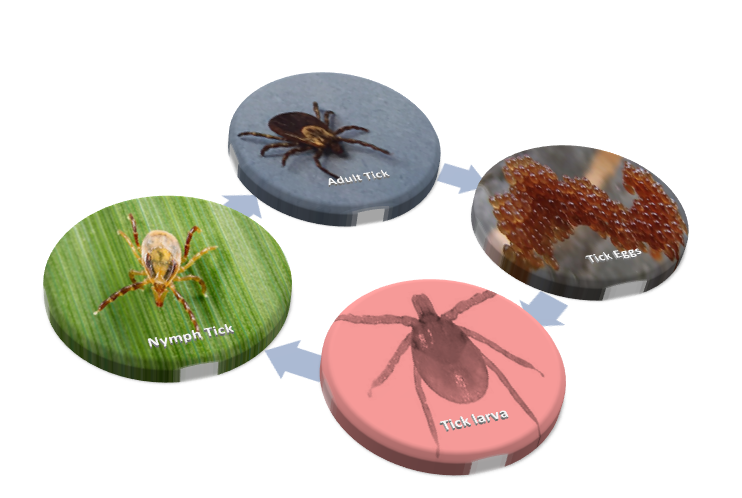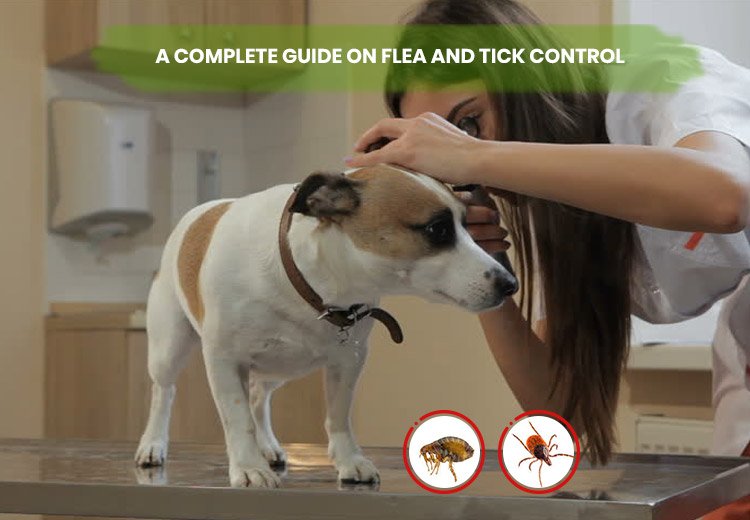Fleas and ticks are ectoparasites that thrive on your pet by feeding on their blood. They are tiny creeps and infest your pet when he/she is busy enjoying in the open.
Let’s learn about them first
# Fleas:
Flea is a common name that represents 2,500 flightless insects. They depend on mammals and birds for their food. They survive by hematophagy, i.e, by feeding on the blood of other animals.
They have four life stages:

Characteristics that make them efficient
- An adult flea is about 3 mm in length
- Brown in colour
- Strong claws that help them to cling on to the body
- Sharp mouthparts; ideal for piercing the body and sucking blood
- Hind legs designed to allow them to jump and hop-on to a host whenever they want
- Flattened body from both the sides that helps them to move through the fur of their host swiftly
- Adult fleas lay eggs and then these eggs are spread in the surroundings and can be found in carpets, beddings, curtains, and clothes.
Problems fleas bring when they infest your pet
- Flea allergy dermatitis, the most annoying condition for a pet
- Itching, reddening of the skin
- Damaged skin, hence a greater chance of infection
- If ingested by your pet then it can be a reason for tapeworm infestation
- Hair loss and dry skin
# Ticks:
Like fleas, ticks are also hematophagy, i.e, they feed on the blood of mammals, birds, reptiles, and amphibians. They are arachnids that neither jump nor fly. These creeps are 3-5mm in length and are of the Parasitiformes class. Developed by the Cretaceous period, ticks like to stay in warm and humid climates. Hence, they are present in the wild questing on the edge of the leaves for a healthy host.
Ticks are mainly of two types Ixodidae - hard ticks with hard scutum and Argasidae - soft ticks with soft scutum.
Ticks, especially hard ticks, are of many types like the American dog tick, Black-legged tick, Brown dog tick, Gulf Coast tick, Lone Star tick, etc, have 4 life stages

Characteristics that make them efficient
- They sit on the edge of the leaves waiting for an ideal host; this process is called questing
- After hatching they have to feed on blood in each life stage to survive and molt
- Each life stage can take up to 1 year
- They have jagged mouth parts that penetrate the skin to suck blood
- In the larval stage, they have only six legs
- Before piercing their mouthparts into the skin they secrete a fluid that numbs the skin and that is the reason why pets don’t feel their bite
- Soft ticks have 7 nymphal stages
- They don’t quest instead they crawl towards their host to infest
- They don’t live in the house like fleas, however, they can be found in the yard in tall bushes and grasses
Problems ticks bring when they infest your pet
- Tick-borne diseases like Lyme disease, Rocky Mountain spotted fever, Tick paralysis, Anaplasmosis, Cytauxzoonosis (a disease specific to cats) and etc, are the main threats of tick infestation
- Blood loss
- Reddened and/or dry skin
- Risk of skin infection
- Hair loss
- Irritated pet
So, these parasites are one of the most common yet most important obstacles that each and every pet parent has to overcome to keep their pet healthy and happy. And by now, you might have very well comprehended the commotion they can cause in a pet’s rather peaceful.
Here are sure shot tips that can help you to control and prevent flea and tick infestation on your pet.
- Regular Check-Up- Whenever you and your pet come home from a long stroll or go out for camping, make sure you feel the skin of your pet while playing. Tick favourite areas are under the collar, under the tail, groin area, between the toes, under the front legs, elbows eyelids, and ears. This would help you in spotting ticks that have chosen your pet as their host. Same for fleas; keep checking the skin in the fur, especially the areas like the groin and armpits. Look for small black specks. You can also see fleas running around on your pet. Combing with a flea comb is also advised.
- Flea And Tick Collars- This is one of the best flea and tick control methods. Collars like Seresto flea and tick collars not only prevent fleas and ticks from infesting your pet but also treat the existing fleas and ticks for 8 months. It also comes with safety releasing technology. Bayopet tick and flea collar is also a very good option to prevent parasitic infestation on your pet.
- Flea And Tick Treatments- A better and faster way to treat parasitic infestations is the oral and topical flea and treatments. These treatments provide quick relief in heavy infestations and provide protection for at least one month. Some of the treatments that you can trust are
- Oral Treatment- Bravecto chews (provide 3 months protection from fleas and ticks),Nexgard, Nexgard Spectra, Program flavor tabs, Program flavor plus tabs and Capstar (to be given daily in heavy infestations).
- Topical Treatment- Frontline Plus, Frontline spray, Advantage, Advantix, and Bravecto spot-on (prevents fleas for 6 months and ticks for 4 months).
- Treat Your House And Yard/Backyard Keep your surroundings flea and tick free which will automatically keep your pet free from these blood-suckers.As mentioned above, flea eggs, larvae, and pupae can be found in beddings, carpets, curtains and even in the yard. You need to vacuum clean your house thoroughly to eradicate eggs and larvae from the environment. Moreover, get your house treated with a flea spray. Do not forget to wash the clothes used by your pet with hot water. Ticks don’t infest your house; they only infest your pets. Hence, to keep them away you need to treat your yard with Diatomaceous Earth that kills parasites by soaking up the fluids and oils.
Also, make sure that you
- Separate the playing area
- Remove the waste wood from the yard
- Get rid of the pile of dead leaves
- Shorten those moist tall grass and bushes in the yard
Fleas and ticks are the parasites that have a strong possibility of re-emerging. So, always be alert when it comes to protecting your pet from these parasites. You can read FLEAS AND TICKS: FIND THEM AND KILL THEM.


